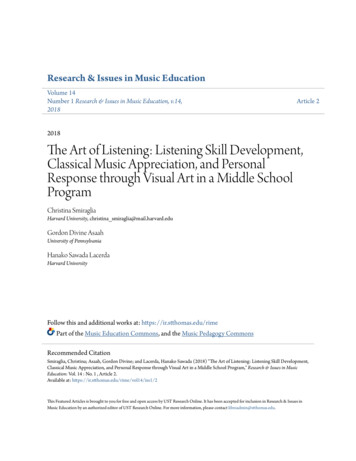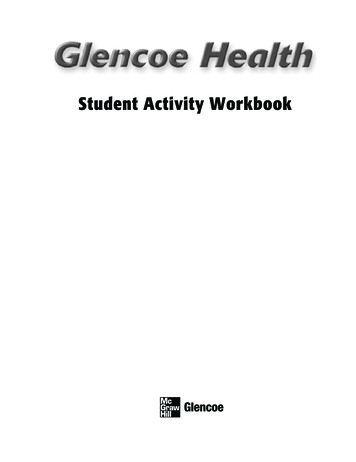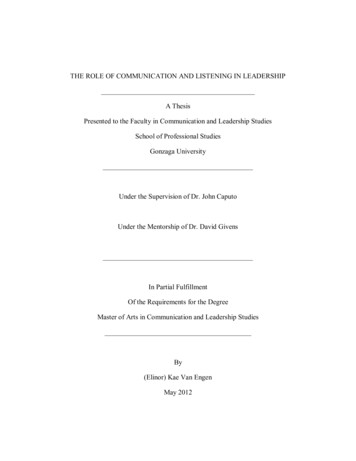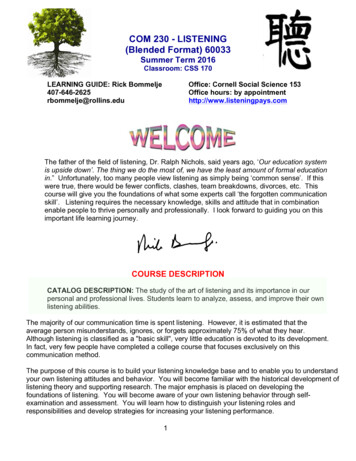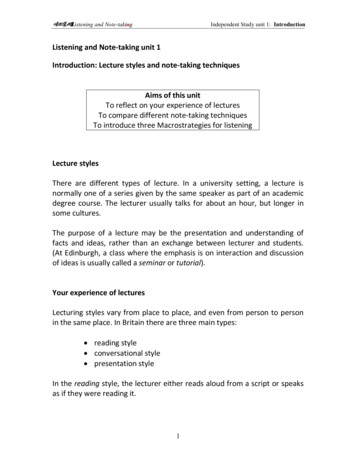
Transcription
/HFWXUH Listening and Note-takingIndependent Study unit 1: IntroductionListening and Note-taking unit 1Introduction: Lecture styles and note-taking techniquesAims of this unitTo reflect on your experience of lecturesTo compare different note-taking techniquesTo introduce three Macrostrategies for listeningLecture stylesThere are different types of lecture. In a university setting, a lecture isnormally one of a series given by the same speaker as part of an academicdegree course. The lecturer usually talks for about an hour, but longer insome cultures.The purpose of a lecture may be the presentation and understanding offacts and ideas, rather than an exchange between lecturer and students.(At Edinburgh, a class where the emphasis is on interaction and discussionof ideas is usually called a seminar or tutorial).Your experience of lecturesLecturing styles vary from place to place, and even from person to personin the same place. In Britain there are three main types: reading style conversational style presentation styleIn the reading style, the lecturer either reads aloud from a script or speaksas if they were reading it.1
Lecture Listening and Note-takingIndependent Study unit 1: IntroductionIn the conversational – or interactive – style, the lecturer speaks from briefnotes, using relatively informal language, and probably encourages thestudents to contribute by asking questions or responding to points in thelecture.The presentation style involves the lecturer using some form of projection –especially PowerPoint or the Net – and may also have issued the studentswith handouts.Reflection Points 1-21. In your country, do you find all three of those lecture styles?2. Do you think one style is easier to understand than the others?To see what lectures are like at other British universities, click on this link:http://www.prepareforsuccess.org.uk/listening to lectures.htmlAfter you have worked through Activity 1 on the Prepare for Success page,check your answers against the Feedback given there.Note-taking in lecturesAs you know, in Britain students are expected to make notes on lectures,even if the lecturer gives out a handout. Normally a handout provides somebut not all of the information the students need to have understood.For many of us, what makes lecture listening difficult - and tiring - is havingto listen and write notes at the same time, as shown below:2
Lecture Listening and Note-takingIndependent Study unit 1: IntroductionThe listener has to decide Step 1what is being saidStep 2what it means (how it relates to what has been said)Step 3whether it is important and whether to note it downStep 4how to write it in note formIn that process, the most important part is Step 3 – evaluating theimportance of information. Notice that it depends on your knowledge ofthe subject, rather than your knowledge of English.Note-taking techniquesNote-taking is a personal thing and there is no single best system. But thereare three basic rules that can help to make your note-taking quicker andmore efficient:Rule 1: Be selective - decide what’s importantRule 2: Be brief - use abbreviations and symbolsRule 3: Be clear - show the relationship between the speaker’s points3
Lecture Listening and Note-takingIndependent Study unit 1: IntroductionRule 1: Be selectiveImagine that a Year 1 undergraduate and a postgraduate studying the sameacademic subject have attended the same lecture. In what ways do youthink their notes would differ?Think about that question and then compare you answer with ours byclicking here.Rule 2: Be briefWhat do these conventional Latin abbreviations mean?e.g.N.B.i.e.etc.cf.What do the initials below stand for? Which others are common in youracademic subject?ILOWHOOPECABCUNESCO4
Lecture Listening and Note-takingIndependent Study unit 1: IntroductionAs well as using ‘official’ abbreviations, you can of course invent your own.Which words could you shorten to the abbreviations below?impbtint’less’lfutestprobSCheck your answers by clicking hereSymbolsSymbols are another very effective tool in note-taking, enabling us toexpress complex ideas in a time-efficient way. Decide on a symbol for themeanings below, and vice versa.symbolmeaning ‘is the same as’in addition, what is more‘causes’ or ‘leads to’ or ‘results in’?something you falls; goes down; decreasesCheck your answers by clicking here5
Lecture Listening and Note-takingIndependent Study unit 1: IntroductionRule 3: Be clearThe relationships between the ideas in a lecture are important, and notesneed to reflect them. There are two common ways of representing theserelationships: traditional linear notes and the alternative mind map.Mind maps are also known as spider notes or web notes. To see anexample, click herePractice in note-takingYou are now going to watch several students talking about theirexperiences at the University of Edinburgh. You will need to listen carefullyand decide what they think are the key points about starting a universitycourse at Edinburgh.Play the whole video once without stopping. It takes about 6 minutes.The video is called Coming to Edinburgh?FIRST VIEWINGWatch and make notes on the main points.SECOND VIEWINGWatch the students again and add to or correct your notes.6
Lecture Listening and Note-takingIndependent Study unit 1: IntroductionEvaluating your notesOn the next page you will find some sample notes made by a Britishlistener, who also watched the Coming to Edinburgh? video twice.First, compare the form of your notes with the British listener’s.Look for differences between the ways in which you may have used abbreviations symbols spatial layout (e.g. linear or web) emphasis (e.g. underlining, capital letters)Next, compare the content of your notes. Are there points where you andthe British listener disagree as to what was said? Are there any points thatyou left out, but the British listener included, which you think areimportant?Macrostrategies for listeningIn this unit, we have looked at note-taking techniques at the micro-levelwhich can help make note-making quicker. But effective listening tolectures in English also requires broad general strategies, calledMacrostrategies, before, during and after listening.PredictingThinking about the possible content of the lecture before you listenMonitoringNoticing your problems as you listen and identifying areas of uncertaintyRespondingGiving your own opinion on the ideas presented by the lecturerIn Units 2-4 we focus on these Macrostrategies and how they can help youget the most out of lecture listening.7
Lecture Listening and Note-takingIndependent Study unit 1: IntroductionSample: A British listener’s notesBenFreshers’ Week – acad fairs – fun eventsClareDiff from school: so much resp for ownlearningLarge classes, so nobody notices if youmissClareFs’ Week not representative: new people,new faces. Coffee crawls. InterestingtoursAmyGet to know the lib system (a bitdaunting); some Ss scared of itAsk Ss and staff for helpBenSocieties Fair (atBRILLIANTJoin lots of socsAlyssa (N. American)UK ‘hands off’ system nobody checksup on youImp to get help earlythePleasance)–ClareAlso soc life within your subjectFollow own hobbies/intsClareDiff forms of support:Tutorials (Ts lecturers or PGs ): focuson readingsFor more serious problems, ask DoSAmyMain advice: get involved, in diff ways: as class rep through (Student) Council – makeyour mark on UoE Socs – to meet new people & learnnew skillsAlyssaRecommends Advice Place run by StudentUnion ( EUSA). Offices in Potterow andat KBClareInitial shock: managing money in her bankaccountBenBe sensible. Take care over spending. Easyto get part-time job.AmyIf you want p-t job, do it from beginning(of your studies) because more free timethen.ClareDaunting: how to make friends, how manysocs to join8
Lecture Listening and Note-takingIndependent Study unit 1: IntroductionStudy NotesHere are some answers for you to compare yours with.#Rule 1: Be selectiveThe quantity of notes depends partly on individual preference and on theability to write (re-code) fast, but mainly on knowledge of the topic. So onemight expect the postgraduate to make fewer notes, assuming they knewmore about the topic and therefore had less need to make full notes.To return to the page you were on, click here#Rule 2: Be briefexempli gratia for example;Nota Bene (note well) it’s important to bear in mind;id est that is;et cetera (and the rest) and so on;confere compare this with;vice versa the other way round.International Labour OfficeWorld Health OrganisationOrganisation of Petroleum Exporting CountriesAustralian Broadcasting CorporationUnited Nations Education Scientific and Cultural Organisation.Personally, I use those abbreviations to mean important, but, international,essential, future, estimated, problem or probable, and student.9
Lecture Listening and Note-takingIndependent Study unit 1: IntroductionSample answers to Symbolssymbolmeaning ‘is the same as’ ‘in addition’ ‘causes’ or ‘leads to’ or ‘results in’?‘not clear to me’ or ‘is that true?’ ‘is greater than’!‘important point’ ‘grows’, ‘rises’; or ‘raises’ ‘is caused by’, ‘results from’ ‘varies with’ or ‘changes according to’#Rule 3: Be clearPersonally, I take linear notes when I’m listening or reading, but I use mindmaps when I’m planning something to write or preparing to give a talk.But the use of mind maps seems to be spreading. I generally find that atleast one student per class (of 15 students, in my case) uses them whenthey are listening to lectures.Tony LynchEnglish Language Teaching Centre201310
Lecture Listening and Note-takingIndependent Study unit 2: PredictingThe best way to use the material in this unit is to find another student who is also interested inwatching the video lecture and making notes. You could then watch the lecture – together orseparately - and then compare your notes with theirs after the second viewing.Listening and Note-taking unit 2How to solve traffic jams(Macrostrategy: Predicting)AimsTo introduce and practise PredictingTo practise note-takingTo engage in critical thinkingMacrostrategy 1: PredictingWe make predictions all the time. For example, we might predict how long it willtake to write an email, or how a friend is going to react to some news we have togive them, or what will be the morning’s news headlines.When listening to a foreign language we can use two main types of information tohelp predict what is going to be said next: background knowledge and knowledgeof context.Background general knowledge of the world knowledge of the foreign culture specific subject knowledgeContext the situation (who is speaking, where and when) the ‘co-text’ – what has been said so far1
Lecture Listening and Note-takingIndependent Study unit 2: PredictingGuessing ahead in this way is a crucial part of effective listening to lectures. Inparticular, you can use your subject knowledge to help you predict what thelecturer is likely to say.In this unit you will be using what you know to help predict what might beincluded in a lecture on urban problems.Pre-listening reflectionThink about your answers to the six Background and Content questions below.(Try and do your thinking in English!)Background1. Is road congestion a common problem in your home country?2. From what you have seen so far, do you think Edinburgh’s traffic problemsare worse than those of the city you come from?3. Why do people prefer to use their own cars than to travel on publictransport?Predicting from content1. What are the negative effects of traffic congestion?2. The title of the lecture in this unit is How to Solve Traffic Jams. From theuse of the word solve, do you expect to hear a story of (A) success, (B)partial success, or (C) failure?3. Do you expect a lecture about specific cases or general situations?2
Lecture Listening and Note-takingIndependent Study unit 2: PredictingPredicting from languageHere are six key expressions selected from the lecture:capacityinsightnudgereferenduminto bottleneckcongestion chargeAre you confident you know their meanings? (If you are working with anotherstudent, ask them).If not, check them in a dictionary such as the Macmillan Online:http://www.macmillandictionary.com/Then think about what you predict the lecturer is going to say about each of theexpressions, in the context of urban traffic problems.The lecturer: Dr Jonas EliassonDr Eliasson is Director of the Centre for Transport Studies at the Royal Institute ofTechnology (KTH) in Sweden. He has researched transport topics such as howsmall charges on crowded bridges affect traffic, what makes a person choose tocycle to work, and how far people opt to live from public transportation. Hehelped design, plan and evaluate Stockholm’s congestion tax, which was pilotedin 2006 and made permanent in 2007. He is frequently brought in as a consultantby other cities that are considering similar charges for rush-hour use of crowdedroads.Dr Eliasson has modelled and appraised several major infrastructure investmentsin Sweden, and chairs the committee for transport modeling of the country’sNational Transport Investment Plan.3
Lecture Listening and Note-takingIndependent Study unit 2: PredictingFIRST LISTENINGListening and note-takingWatch the lecture straight through, without stopping.Make notes - but don’t worry if you don’t have time to note down all theinformation you need to. You will get another chance.As you listen, focus on the Predicting macrostrategy: Keep in mind the six questions you reflected on Use what you know and what Dr Eliasson has said to guess at what he willsay next Use his Russian story (about the planner who rang a planner in London) topredict how the story is going to link to his main pointTo watch the video, click hereSECOND LISTENINGDetailed note-takingAs you may have noticed, the lecture webpage provides a transcript in Englishand may also offer a translation into your language. You might want to use one ofthem as you play the lecture again, or you could wait until the end beforechecking your notes against the transcript.(To think about: Is it better to use the transcript or the translation, if you want toimprove your English listening skills?)Now play the lecture a second time, again without stopping.4
Lecture Listening and Note-takingIndependent Study unit 2: PredictingAs you listen and/or read, study your notes carefully and add new notes at pointswhere during the first listening you didn’t catch what Dr Eliasson said you didn’t have time to note all the details you misunderstood what she saidComparing notes: ContentCompare your notes with the transcript on the lecture webpage (or if possiblewith the notes of another student).Have you identified and noted the main points?If there were points (or words) that you could not catch as you listened, study thetranscript (or see whether the other student can help).Comparing notes: FormIf you have been working with another student, compare the form of your noteswith theirs. Look for differences between the ways you have expressed the sameinformation.Have you used any of the following in your notes: abbreviations symbols emphasis (e.g. underlining, capital letters)5
Lecture Listening and Note-takingIndependent Study unit 2: PredictingReflection (or discussion with another student)1How did you do with your predictions? On page In session 1 you andanother student predicted the points you thought might be mentioned inthe lecture. Did Jonas Eliasson include any of them? (For example, was hislecture about success, partial success or failure?)2Have congestion charges been tried in (any part of) your own country?3Edinburgh City Council held a referendum some years ago on a plan tobring in a congestion charge for the city centre. Would you have voted foror against?Critical thinkingWhat was the connection between the Russian story and the Stockholm casestudy?Dr Eliasson’s central point is the importance of nudging people into changing theirbehavior. What exactly do you think he meant?Do you think ‘nudging’ would be effective in your home country? What are thealternatives to nudging in public policy?Here is what one viewer, Jen Oh, commented on the TED website:Dec 17 2012:As an urban transport specialist, I am of the view that Jonas Eliasson oversimplified how the congestion problems might be addressed and understatedthe role (and importance) of planning. It is true that Stockholm is one of themore successful examples of similar schemes, but its success was possiblebecause of the "alternative" options that had been made available to the6
Lecture Listening and Note-takingIndependent Study unit 2: Predictingcitizens. People could choose to use public transport that is reasonably fast,reliable and safe, or adjust their departure time flexibly as the system(employers or other services that they need to travel to) allowed them to doso. And good planning is essential to provide those good alternatives andfundamentals of urban development that determine the patterns andflexibility of trips. In many developing and emerging cities, this is not thecase.Also the notion that you can "nudge" people with a relatively small incentive,such as 1 or 2 euros, also depends on how willing the users are to pay. Howmuch extra cost would it take for a commuter to give up the privacy,independence and comfort of driving their own car and instead use publictransport? In many other places where public transport is not welldeveloped, it would take a lot more than a "nudge" to alter behaviors.Do you think any issues about congestion are left unanswered after the lecture?If so – and if you can - discuss them with another student.Tony LynchEnglish Language Teaching CentreUniversity of Edinburgh20137
Lecture Listening and Note-takingIndependent Study unit 3: MonitoringThe best way to use these materials is to find another student who is also interested inwatching the video lecture and making notes. Watch the lecture – together orseparately - and then compare your notes with theirs after the second viewing.Listening and Note-taking unit 3The Future of Lying(Macrostrategy: Monitoring)AimsTo practise Macrostrategy 2 – MonitoringTo interpret cultural references in a lectureTo focus on helpful signalling in a lectureMonitoringMonitoring means ‘checking’ or ‘observing’ that you have understoodsomeone is saying to you. It is an important part of effective listening,especially in a foreign language.When reading, we can always go back and read something again if we arefinding it hard to understand. Listening is more difficult in this respect. In aconversation we may be able to ask the speaker to repeat or explain, butthat is not so easy in a lecture.In a university lecture, you can expect the lecturer to keep more or less tothe same subject. But there may be points where they ‘change direction’ –for example, presenting contrasting opinions on the subject, or givingexamples that contradict each other.So in the process of lecture listening, Monitoring involves asking yourself: Have I heard that correctly? Have I understood what the speaker meant? Have I understood why the speaker said it? Has the speaker changed topic? Where is this leading to?1
Lecture Listening and Note-takingIndependent Study unit 3: MonitoringSometimes what makes it difficult to understand parts of a lecture is notthe language the lecturer has used, but the cultural knowledge theyassume the students have.That is particularly true when a speaker makes a joke, or mentions a recentlocal event, and expects the students to make the appropriate connections.We have some examples of that in this lecture, which is why it is goodlistening material for practising Monitoring.Pre-listening reflection (or discussion)ContentThe lecture is about lying – mainly the small lies (white lies) that we tellevery day. Or do we?1. Define the word lie. What are lies for?2. Have you told a lie in the last 24 hours?3. Is it a bad thing to be a good liar?LanguageThe lecturer mentions three types of lying that are common in today’selectronic communication:The ButlerThe Sock PuppetThe Chinese Water ArmyWhat are the literal meanings of those words/expressions. (You could checkthem on Wikipedia) That will help you understand why the lecturer usesthem with particular meanings to in his talk.2
Lecture Listening and Note-takingIndependent Study unit 3: MonitoringThe lecturerDr Jeff Hancock, from Canada, is an Associate Professor of Cognitive Scienceand Communications at Cornell University, USA. His academic researchfocuses on how people use deception and lies when communicatingdigitally - sending texts, composing emails, writing online profiles, and soon.Dr Hancock believes that, although the impersonality of online interactioncan encourage mild fibbing (those white lies), the fact that it leaves apermanent record of verifiable information keeps us honest.Monitoring your understanding of the lectureProfessor Hancock has a very informal style. He smiles a lot, uses colloquiallanguage and, as you will hear, makes the audience laugh throughout histalk. You will probably understand some of his jokes, but not others. Don’tworry! We will be taking that into account in the Listening tasks.FIRST VIEWINGMonitoringFor this first viewing, just watch and listen. Don’t make any notes. Don’tread the transcript. Play the video without stopping – roughly 18 minutes.Each time you hear the audience laugh, write down a percentage toindicate how sure you are that you have understood why they arelaughing. For example, if you had absolutely no idea what ProfessorHancock has said, you would put 0%. If you are confident you haveunderstood perfectly, you would put 100%. If you knew he was making ajoke about Canada, but not more than that, you might put 30%.In most cases, you can expect your understanding to be somewhere in themiddle, between 0% and 100%.To watch the video, click here3
Lecture Listening and Note-takingIndependent Study unit 3: MonitoringSECOND VIEWINGNote-takingThis time, watch the whole video and make notes on what you think arethe main points. Don’t read the transcript yet.Comparing notesNow compare your notes with the transcript on the lecture webpage (or, ifpossible, with the notes of another student).Content Do you agree how many main points there were in the lecture? If you missed other points, has your partner made notes on them? If there were points (or words) that you could not understand, checkin a dictionary or ask someone else to help.Form(For this you need another student). Look for differences between the waysin which you have used abbreviations symbols layout (e.g. linear notes or spider’s web) emphasis (e.g. underlining, capital letters)MonitoringCompare the ‘confidence’ scores you gave yourself during your firstlistening. Did they vary much from point to point during the lecture? (Arethey similar to the other student’s?4
Lecture Listening and Note-takingIndependent Study unit 3: MonitoringFocusing attention in a lecture: SignallingIn your lectures at Edinburgh, you will probably find that some lecturers aremore difficult to follow than others.One way to help yourself is to listen out for words signalling that thelecturer is summarizing or reformulating what they have said so far, or thatthe next point is important.Here is example from Jeff Hancock’s lecture:But I think there's actually something much more interesting and fundamentalgoing on here. The next big thing for me, the next big idea, we can find by going wayback in history to the origins of language. Most linguists agree that we started speakingsomewhere between 50,000 and 100,000 years ago. That's a long time ago. A lot ofhumans have lived since then. We've been talking, I guess, about fires and caves andsabre-toothed tigers. I don't know what they talked about, but they were doing a lot oftalking, and like I said, there's a lot of humans evolving speaking, about 100 billionpeople in fact. What's important though is that writing only emerged about 5,000 yearsago. So what that means is that all the people before there was any writing, every wordthat they ever said, every utterance disappeared. No trace. Evanescent. Gone. So we'vebeen evolving to talk in a way in which there is no record. In fact, even the next bigchange to writing was only 500 years ago now, with the printing press, which is veryrecent in our past, and literacy rates remained incredibly low right up until World War II,so even the people of the last two millennia, most of the words they ever said -- poof! -disappeared.Underline what you think is Jeff Hancock’s main point in that extract. Whenyou have decided on your answer, have a look at mine on the next page.Further discussionI’m sure there will be issues arising from the lecture that you would like todiscuss. If so, talk about them with the other student – or with someoneelse.5
Lecture Listening and Note-takingIndependent Study unit 3: MonitoringMy answerBut I think there's actually something much more interesting and fundamentalgoing on here. The next big thing for me, the next big idea, we can find by going wayback in history to the origins of language. Most linguists agree that we started speakingsomewhere between 50,000 and 100,000 years ago. That's a long time ago. A lot ofhumans have lived since then. We've been talking, I guess, about fires and caves andsabre-toothed tigers. I don't know what they talked about, but they were doing a lot oftalking, and like I said, there's a lot of humans evolving speaking, about 100 billionpeople in fact. What's important though is that writing only emerged about 5,000 yearsago. So what that means is that all the people before there was any writing, everyword that they ever said, every utterance disappeared. No trace. Evanescent. Gone.So we've been evolving to talk in a way in which there is no record. In fact, even the nextbig change to writing was only 500 years ago now, with the printing press, which is veryrecent in our past, and literacy rates remained incredibly low right up until World War II,so even the people of the last two millennia, most of the words they ever said -- poof! -disappeared.Dr Hancock signals that a main point is coming by saying “What’s importantthough is ” and begins the next sentence with “So what that means ”So I think the part I’ve shown in red is the main point in his mind.Tony LynchEnglish Language Teaching CentreUniversity of Edinburgh20136
Lecture Listening and Note-takingIndependent Study unit 4: RespondingAs before, the best way to use this unit is to find another student who is also interestedin watching the video lecture and making notes. You can then watch the lecture –together or separately - and then compare your notes with theirs after the secondviewing.Listening and Note-taking unit 4Keys to language learning(Macrostrategy: Responding)AimsTo present and use Macrostrategy 3 – RespondingTo exploit rhetorical questionsTo round off the Listening and Note-taking courseMacrostrategy: RespondingBeing an effective lecture listener involves not simply receiving what thelecturer says but also responding to it. Responding here means relating thelecture content to your knowledge and personal experience, and formingyour own opinions. Responding involves asking yourself questions such asthese: Do I accept that what the lecturer says is true and relevant? Can I think of other examples that support – or don’t support what is being said? Do I think the lecturer’s opinions are reasonable?The topic of this unit provides a good opportunity for this sort of responsivelistening. The lecturer is a well-known researcher into the ways in whichvery young children learn their own language and how they have thepotential to learn others.You will able to use your own experience of learning English to respond towhat you hear her say in her talk.1
Lecture Listening and Note-takingIndependent Study unit 4: RespondingIntroduction to the topic: How babies learn language(s)Pre-listening reflection (or discussion): Content1. What do you remember of your very first lesson in English?2. Do you remember learning your mother tongue? What are yourstrongest memories of mother tongue lessons at primary school?3. What do you believe is the best age for learning a foreign language?Why do you think that?If you can, discuss those questions with another student. If not, think aboutwhat your answers would be.The lecturerProfessor Patricia Kuhl is Co-Director of the University of WashingtonInstitute for Learning & Brain Sciences, and Professor of Speech andHearing Sciences. She is internationally recognized for her research on earlylanguage and brain development, and studies that show how youngchildren learn. Her work has played a major role in demonstrating howearly exposure to language alters the brain. It has implications for criticalperiods in development, for bilingual education, and for research oncomputer understanding of speech.FIRST VIEWINGListening and note-takingProfessor Kuhl’s talk lasts about 11 minutes.On this first hearing, try to note down the main points. You will get asecond chance to pick up additional information later.As you are listening, think about your personal response to her points, byasking yourself these questions:2
Lecture Listening and Note-takingIndependent Study unit 4: Responding Do you think that what Professor Kuhl says about identifyinglanguage sounds is true? Can you think of other examples that support – or don’t support what she says?As usual, make notes on a blank sheet of paper.To watch the lecture, click hereSECOND VIEWINGDetailed note-takingDid you notice that Patricia Kuhl used a series of questions in her talk? Theyprovide a clear structure to the topics she wanted to discuss. When aspeaker asks a question in this way and then goes on to give the answerherself, it is called a rhetorical ques
Lecture Listening and Note-taking Independent Study unit 1: Introduction 2 In the conversational - or interactive - style, the lecturer speaks from brief notes, using relatively informal language, and probably encourages the students to contribute by asking questions or responding to points in the lecture.



